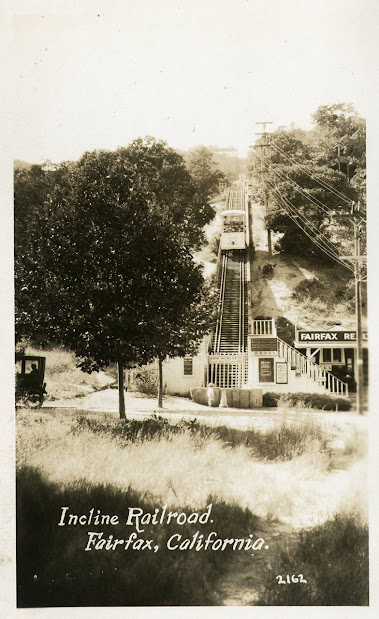You are looking at two wonderfully crisp photographs of Fairfax’s Funicular or Incline Railroad, in operation between 1913 and 1929. At the foot of the track, we see a small child, the silhouette of a man in the backseat of a shaded automobile, and Fairfax Realty Company, sellers of “new bungalows and choice building lots” in the newly accessible subdivision of Manor Heights. The town of Fairfax appears young and rural, with a smattering of houses, a large school, and a robust-looking Fairfax Lumber Company.
Inspired by incline railroads of the Alps, Fairfax Manor’s funicular was conceived by Edward S. Holt, president of the Fairfax Development Company, who partnered with George D. Gray to bring his vision to life. The railroad would bring prospective homeowners up and down the 500-foot elevation in three to five minutes at five cents per fare, connecting them easily to Manor’s burgeoning business district and the Northwestern Pacific Railroad line for those commuting to the city.
The funicular’s 26-seat passenger cars traveled 500 feet per minute along 1,500 feet of track, from Sequoia Road to upper Scenic. The San Francisco Call reported on August 2, 1913, “The railroad rises from the center of the tract to the plateau amid scenes of unsurpassed beauty and verdure and discloses a panorama of hill and valley such as only Marin County can offer.” Although “liquor and ragtime resorts” were initially banned from Manor, a tavern and dance hall were eventually built at the top of the incline.
As fun as the funicular railway looks, the word actually derives from the Latin funiculus, meaning “rope.” As early as the 1500s in Europe, funicular or incline railways were operated by rope cables powered by people or animals. The first funicular in the United States, the “Mon Incline,” as it is known, opened in Pittsburg in 1870 and is still in operation today. Fairfax’s funicular opened amid other California incline railroads like Angels Flight in L.A. and Catalina’s Island Mountain Railway—no doubt all electrical engineering marvels of the time.


